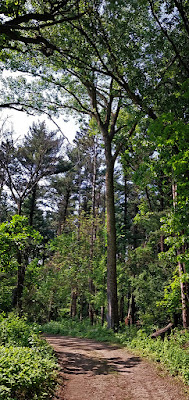"Observe always that everything is the result of change, and get used to thinking that there is nothing Nature loves so well as to change existing forms and make new ones like them."
― Marcus Aurelius
Holy smokes, it's June already.
My go-to spot for observing and photographing Six-spotted Tiger Beetles (Cicindela sexguttata) at Pope Farm Conservancy has been a disappointment so far this spring. Normally, the long rock wall that cuts across the property is a reliable place to find them in May—perfect for capturing clean, low-angle portraits. You can sit right up against the rocks and boulders, often with beetles darting around just inches away. But this season, the wall has been quiet—there haven't been any. Having said that, I have been finding them in good numbers at other locations. What's going on?
I think I might have an idea ...
Here are high and low temps on days I did find them on the rock wall since 2020:
- May 30, 2020: High 75°F, Low 52°F
- May 30, 2021: High 86°F, Low 70°F
- May 11, 2022: High 86°F, Low 70°F
- May 16, 2023: High 79°F, Low 47°F
- May 21, 2024: High 85°F, Low 60°F
It hasn't been this warm so far this spring. Every visit Pope Farm this spring, the highs have only reached the 60s. The rock wall sits on a hill, exposed to open sky and wind, with just a few scattered trees nearby. In contrast, the other places are wooded trails, partially shaded by a canopy and buffered by understory growth. These forested paths likely offer a more stable microclimate: moderating temperature swings, retaining moisture, and shielding against wind. That creates a more favorable environment for beetle activity early in the season. Meanwhile, the sun-exposed rock wall may heat up quickly on a clear day, but its openness makes it more vulnerable to cold snaps and wind chill—possibly stunting or delaying beetle emergence.
I recall finding Six-spotted on the Grady Tract's trails—part of the UW Arboretum—a few decades ago. It just happened to be Ken Wood's favorite location for them (d. 2013). Incidentally, Ken was a prominent figure in the Madison naturalist community. He served as a guide and educator at the UW Arboretum for over 30 years, where he taught classes, organized conferences, and authored publications on various plant collections. His deep knowledge of prairie plants and birds made him a respected leader on field trips, particularly those organized by the Madison Audubon Society, where he also served as board president.
Along the trail there were Lupines ...
A closeup ...
And also The Enemy ...
The "Sixers" (as Lori and I call them) were abundant!
As you look at these portraits, observe the variance in maculations or spots.
I could photograph them all day.
These little mysteries of Nature are interesting to me, but perhaps the Grady Tract will become my new favorite location for this species. Chances are, though, I'll continue to check the rock wall as summer's temperatures warm it up.
All images © 2025 Mike McDowell




















